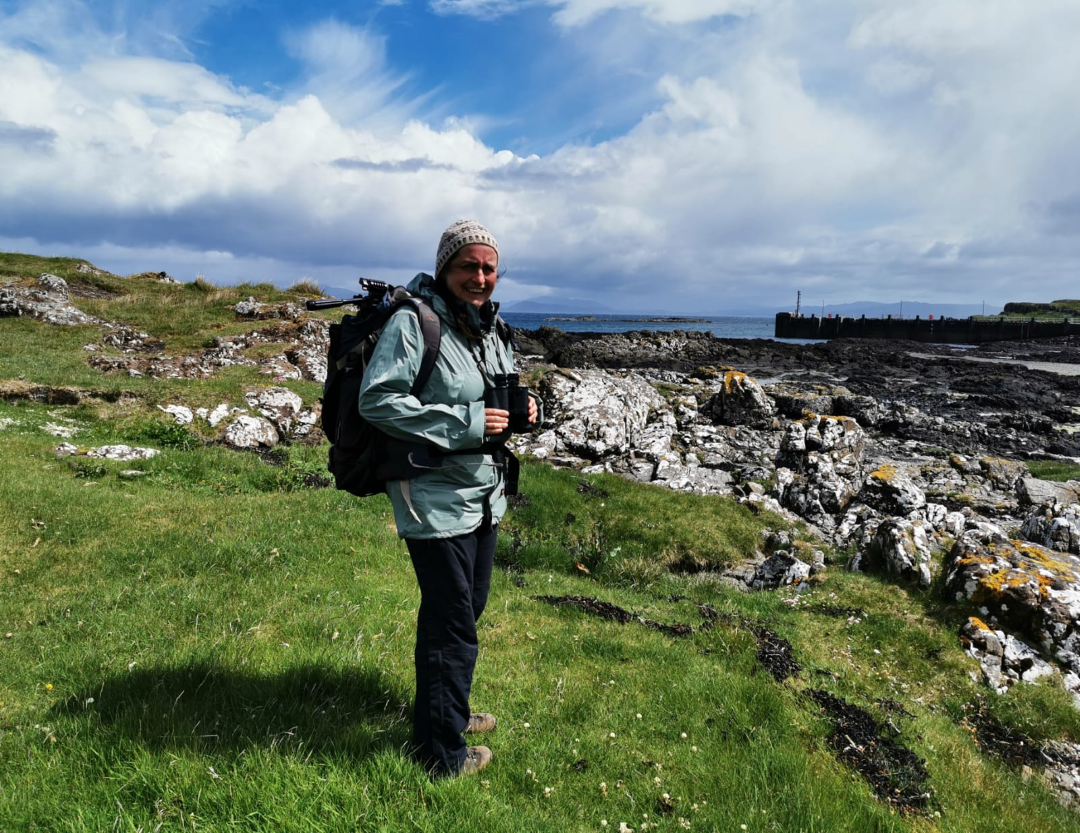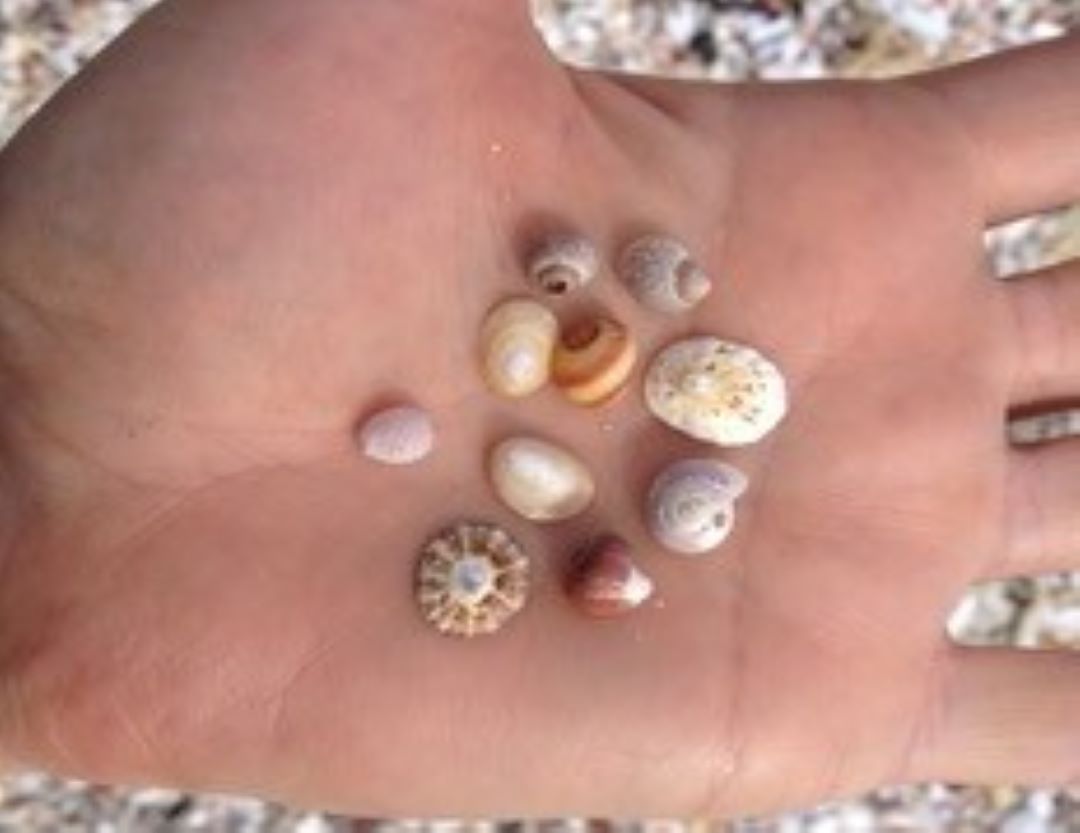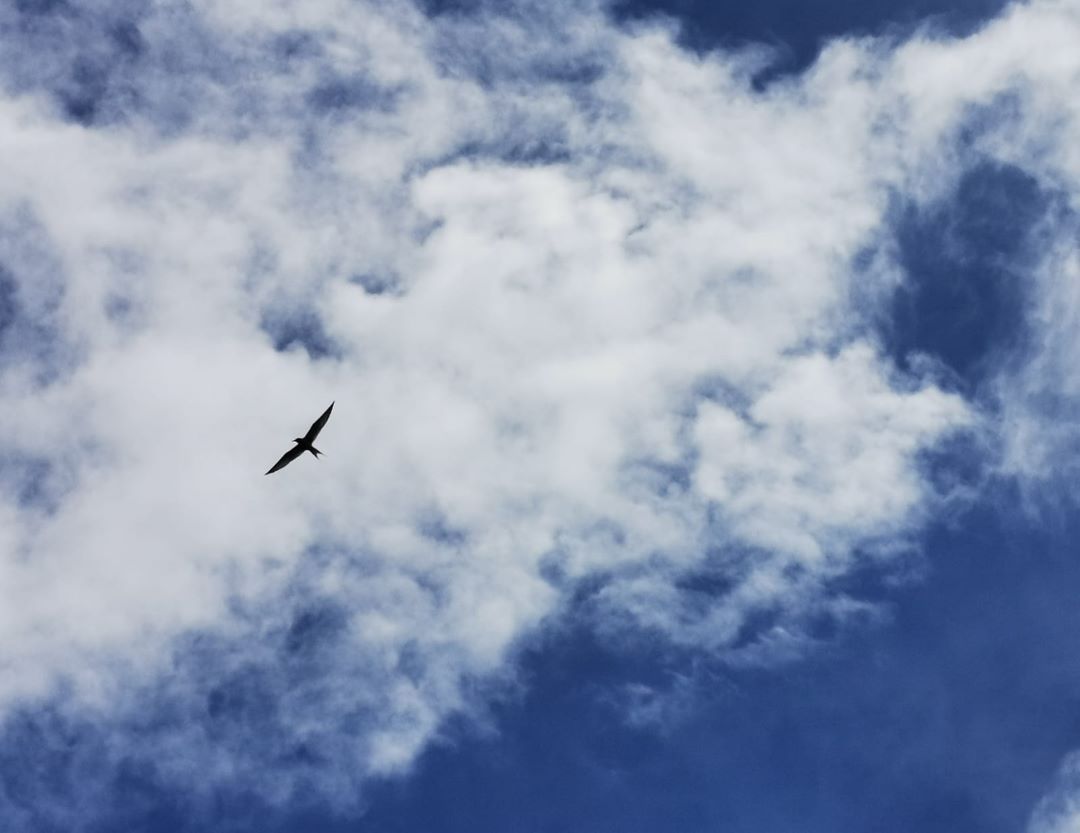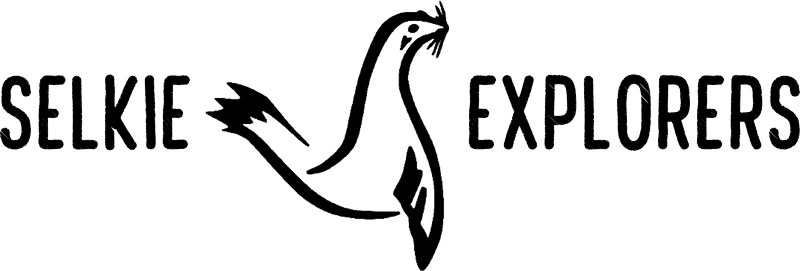It is early June and the heatwave of May has been ousted by blustery chill winds driving out of the North. Norah Barnes has agreed to meet me on the deck of my boat Selkie at low water. Twice a day the sea enters and retreats with the tides leaving Selkie sat high and dry in the bay. Norah negotiates the awkward high step up a flimsy ladder. I offer tea and biscuits to entice, tucked under the capot by the salon door, sheltered from the elements.
I am making it easy for myself. When I decided to explore Eigg’s connection to the sea, who better to talk to than my good friend Norah! Norah is the Scottish Wildlife Trust (SWT) ranger, an Isle of Eigg Heritage Trust (IEHT} Director and one half of The Earth Connections Eco Centre. We have kids the same age in high school at Mallaig and she has played a key role in my island life as a fellow parent, but also sharing a bond through our love of the sea, nature, singing and swimming. We have brought all these passions together, using Selkie as a birdwatching/diving platform and a vocal stage. I remember in particular a very rough journey home from the mainland when we were feeling a little under the weather: Peeking over the cabin roof to steady the horizon, we sang an African song that timed perfectly with the pounding waves and lashing rain… and made the passing of time easier on the stomach!
Norah is a vibrant passionate person, easy to talk to and quick to laugh. She has an enormous heart and believes deeply in community and sustainability. Coupled with an admirable understanding of organizations and their systems she is able to bring her many talents into play. It is a real eye opener talking with her, hearing her story and realizing the drive and commitment that she has developed from a young age, caring about the planet on such a profound level that she, with her partner Bob, has devoted her life living by her beliefs.
I hope you enjoy getting to know about her as much as I have and I hope you will check out my Facebook and Instagram stories with Norah and our families as we go exploring the seashore on 8th June, World Ocean Day.
Norah
Early life, education and influences
I grew up in Shetland where my parents moved to when I was little. We lived by the sea and i spent my childhood looking around rock pools and playing on beaches. Shetland has a strong sea tradition in its Norse history, folklore and fishing, and I always kept that with me: the sea has always been my constant.
I studied Environmental sciences at Stirling University and volunteered with Stirling Ranger service and Conderation Volunteers in my spare time. I helped with environmental education with groups of kids during the summer months, developed my love of wildlife and found a passion for education. I spent a year in the USA on the Earth Education program which is a deep immersion into nature, and worked at outdoor centres in the States and Australia. When I came back to the UK I worked as an education officer for Shetland Field Studies Trust, and as a wildlife ranger in Loch Lomond, Glasgow and Edinburgh.
I then did a second degree in Human Ecology at Edinburgh. I wanted to explore deeper questions about ecology, our place on the planet and, as humans, our relationship with the earth. It was a very challenging and interesting course. It made me commit to trying to be more environmentally friendly in my life in action.
Environmental Centre Dream
It was on this course that I met my partner Bob and we first dreamed of setting up an environmental centre where we could put everything we had learned into action. We wanted a place for other people to come to learn practical positive things that they could do to help the planet. We spent a couple of years on Talisman, sailing around west coast Scotland looking for somewhere to build our centre.
Did you definitely want to be near the coast?
Oh absolutely. Bob’s a great lover of the oceans and we both definitely wanted to live by the sea. We were looking at moving back up to Shetland too but wherever we found, it had to be by the coast.
What brought you to Eigg?
There was a lot of luck involved. we looked around at places all over the west coast, but most places are privately owned. Trying to find a piece of land is difficult. Then somebody on Eigg got in touch with us. There were new crofts created which gave the opportunity for people to come at that time. We came to visit and found that the crofts were not for us. However, there was the old laird’s house and we acquired that.
Eigg’s sense of community definitely appealed. One of the lecturers on the Human Ecology course was Alistair Mackintosh who has written quite extensively about Eigg and was one of the original trustees. So, we knew about Eigg and community buyout and it was something that we were both interested in personally. We liked the idea of being part of a community that ran things for themselves.
First years on Eigg and Earth Connections Centre
The new pier had just been built so were able to moor our boat in the old harbour. It was sheltered enough for us to live on Talisman as the house was in too bad a state to stay in. We had two small children at the time, so we were fixing up the house and making plans for our Centre.
We did really enjoy living down there. It was just so nice to be right close by the sea and aware of the tides and the weather and the birds around us. We lived on the boat for 2 -3 years. The Talisman is an old boat that needs a lot of work on it but we both found it quite a satisfying way of living. It is hard but you are in touch with the natural elements which we both liked, and you are self-sufficient. There’s an environmental aspect of living on a boat where you can’t use too much stuff, you’re living within your means basically. We got water from shore cottage, the pier and we did try and get it from the burn but that was not very easy. We could take our little dinghy over to the pier and fill up several containers.
We have been on the island for 16 years now, and our Centre has been running for several years. We have run various courses on green living and practical workshops, hosted volunteers and students from all over the world. We have also hosted TV crews, theatre groups, and been a venue for music and community events.
The community of Eigg has grown and there are a lot of new people here. I think the Trust has still got the same aims of preserving the natural and cultural heritage of the island. However, we have become more involved as a “green “island promoting renewable energy, eco tourism, growing food etc which we fully support.
Eigg and the Sea
Do you think the island has got much of a connection with the water?
It is strange, for it being an island community there doesn’t seem to be such a strong connection to the sea, compared to Shetland anyway. I suppose historically it has been more of a crofting community, rather than a fishing one perhaps. There are one or two people who fish locally in their own boat, but the Small Isles/Mallaig fishing community has dwindled. There were definitely more when we came here. Stewart Millar had a fishing boat that Dean and Angus worked on. We would see them quite a lot and hear their stories. There were a few more people who picked winkles on quite a big scale. We and other people do collect seaweed every year for our gardens.
I think now our relationship with the sea is one more of inspiration and enjoyment, rather than an economic or survival one.
Scottish Wildlife Trust Ranger
SWT is a partner in IEHT so it has a say in the overall running of the island. It played a big part in the buyout, fundraising and campaigning for the island. There has been a ranger on Eigg since before the buyout. John Chester was the first. John spent 20 some years doing a huge amount of wildlife surveys and he created a data base of records of all the birds, plant life and other wildlife on the island. This is a really important resource.

The role has changed and developed over time. My role is still to carry on doing those surveys, but I also have a remit in visitor engagement and raising awareness about wildlife issues in general. More people visit Eigg now. It is a popular holiday destination. In particularly there are a lot of people who come here who are interested in wildlife and eco issues. I am there to help facilitate things by doing guided walks and events and I run an environmental education group for the kids as well.
The work is very varied and we do a bit of practical work. Initially SWT did do a lot of the practical conservation work that was needed after the buyout as some things had got run down. SWT organized work parties for clearing rhododendrons, fencing woodlands area and creating new ones. We still do that but now but in conjunction with trust volunteers and contractors.
Wildlife Surveys
How much of your time is Ocean based?
Ideally, if it was up to me I’d do a lot more. We do coastal bird surveys. Shore birds (those nesting around shore) – oyster catchers, arctic terns, ring plovers – we check their nests and keep an eye on numbers. On Castle Island we have guillemots nesting there so we try and do a count of them. In the past, counts were done of fulmars nesting on the west coast cliffs of Eigg but over the last 10 years they have just gone. It is puzzling me as I haven’t got a reason or explanation. I looked into it a little bit and everything is a bit vague. John says that it could be to do with climate change, overfishing, or it could be just be a more localized thing and they’ve gone to another island.
Is it to do with the sea eagles?
It could well be. It would need a specific detailed study to do that, which I don’t have the time to do unfortunately.
We also take any records of marine life sightings that people see from the shore or on boats.
Whale and Dolphin Conservation (WDC)
I do marine life watching more formally through shore watch with WDC. Tasha Lancaster is the main person involved in this and she trained Trust volunteers to help with it during last summer. The site is above the pods looking at the sea out and north of Castle island. The initial site was too far away. Now it is nearer the pier, islanders and visitors will come and chat to me and I can tell them all about it. Part of the project is to engage with visitors. It’s handy for me doing my SWT walks and events. We also moved the site a little over the road so we can see south of the island too. Possibly, this summer, locals could get more involved with these surveys. They only take 10 minutes. We can make it Covid safe with gloves and hand sanitizer.
Learning about the wildlife
I did weekly shore walks with visitors last year these were very successful. It is a nice easy walk for people to do around Galmisdale bay. There is loads of wildlife to see and I’ve learnt lots. Doing it regularly every week really helps me and my learning journey. I didn’t know where the Eider ducks nested before. I didn’t know that they grouped up. At the moment, there are 20 odd ducklings but there are 3 families that group up together.
There’s all the different wild flowers at the beach. There are plants that adapt to the salt, there some salt marsh plants, the banking plants which are all very different to the other wild flowers. Right now I’m trying to learn about shells and the creatures in the rock pools which has been a love of mine since I’ve been little.
As you know I like swimming. With my family we do swimming and snorkeling and see all those little fish and I don’t know what they are. So, fish are something that I’d like to know more about. There is always so much to learn which is why I do like doing this job. I have a certain amount of flexibility. Because I am personally interested in the sea, I am lucky I am able to bring that more into the job.
Snorkel Trail
 We are starting a project for snorkeling. SWT started the snorkel trail up in Ullapool. I lust started developing a site for all the Small Isles. An application was put in for funding but stopped because of covid. Camille Dressler is spear heading this. Rum and Canna have people doing the same and we will collate information for each island to produce a joint leaflet..
We are starting a project for snorkeling. SWT started the snorkel trail up in Ullapool. I lust started developing a site for all the Small Isles. An application was put in for funding but stopped because of covid. Camille Dressler is spear heading this. Rum and Canna have people doing the same and we will collate information for each island to produce a joint leaflet..
There will be a self – guided leaflet showing a couple of areas and access points in Craigaid and Galmisdale bays. It will contain levels of difficulty, safety awareness information on it, along with what to look out for.
(I can feel a Go pro virtual snorkel tour coming up).
Covid Impact
There are no visitors to island at the moment and we are uncertain as to when they are going to return so I’m not doing any work with the public: no weekly walks or events. This has given me a bit more time to concentrate on other areas. Hence the survey works and I have time for more visiting other bits of the island. I am learning and expanding my knowledge.
Sustainability
World Ocean Day is all about sustainability. How sustainable is Eigg with it’s ocean?
One of our aims at the Eco Centre is to help people understand more about sustainability and trying to put that into practice. I want to help people see the bigger picture – of how everything in life is connected and how we are connected to the natural world. This is a big part of my life and how I feel about things. I think World Oceans Day is very important in that sense to help people learn more about oceans.
Eigg has a lot of sustainability projects on the go from renewable energy to woodfuel business. It is very concentrated on thing it does on the island to help improve people’s lives, but it is also involved with bigger projects/networks such as Green European Islands. I was thinking about the Small Isles marine protection area. I don’t know why Eigg wasn’t put in area. I think it’s a little off people’s radar now really which is a shame. Maybe by just talking and posting about it and using WOD as a means to educate people on the island we can get them more interested.
We have also started regular beach cleans last year with our local Green action group, and had some awareness raising events about plastic pollution, recycling and composting etc.
Blue Carbon
There is so much to know about the ocean. The ocean is vital to the planet’s working, in ecological terms and scientific terms, which a lot of people don’t realise. I am just learning about the blue carbon which is how the ocean captures and absorbs carbon. It is such a vital role and we generally aren’t really aware of that. We think of the ocean more as a place to enjoy and admire all the wildlife in it. That is one level but then there is another far more important level which is that we need it: it’s part of our survival. So, there is always more work to do around that.
I think the ocean is seen as a resource. It is where we can get food from and how we transport goods around the word from. It is seen in very practical terms and that whole other level of being vital for our survival is maybe not so well understood. Programs like World Ocean Day and Ocean Literacy are really important.
World Ocean Day 8th June. What can we do?
What can we do when we go to the beach on WOD to augment ourr enjoyment that adds to the bigger picture?
In simple terms you can watch a short film to pinpoint one or two things for environmental information.
If it wasn’t for covid I would organize a big event which would be more about just exploring the sea, looking in rock pools, maybe doing snorkling and that kind of thing.
And unfortunately, plastic rubbish is still being brought in on our beaches form the sea, so people can always do beach cleans as a short term solution.
If you can’t get to the sea, what can you do?
Buy less plastic!
It takes 60 days to start a habit. What one everyday thing would you suggest people can do to help our oceans?
Using a drinking bottle instead of buying plastic bottles of water. Plastic bottles are still one of the most numerous items that appear on beaches.
What would be a song to listen to on WOD?
One of my favourite songs is Crosby Stills and Nash – To the Last Whale, which has an environmental message. I do like to sing sea shanties as well with our singing group for a bit of fun.
We were interrupted by Norah’s phone ringing – island business. I peeked out and saw a line of brightness. The tide was coming in and I needed to move my car, so it didn’t try life out as an amphibious vehicle. We donned jackets and binoculars and scouted around Norah’s survey area. Much excitement seeing a ringed plover dancing our attention away from a chick/egg that we didn’t find. And even more excitement to see eggs and chicks from 3 pairs of oyster catchers. Brilliant afternoon. I’d like to thank Norah immensely for giving me the time and telling me about herself.
